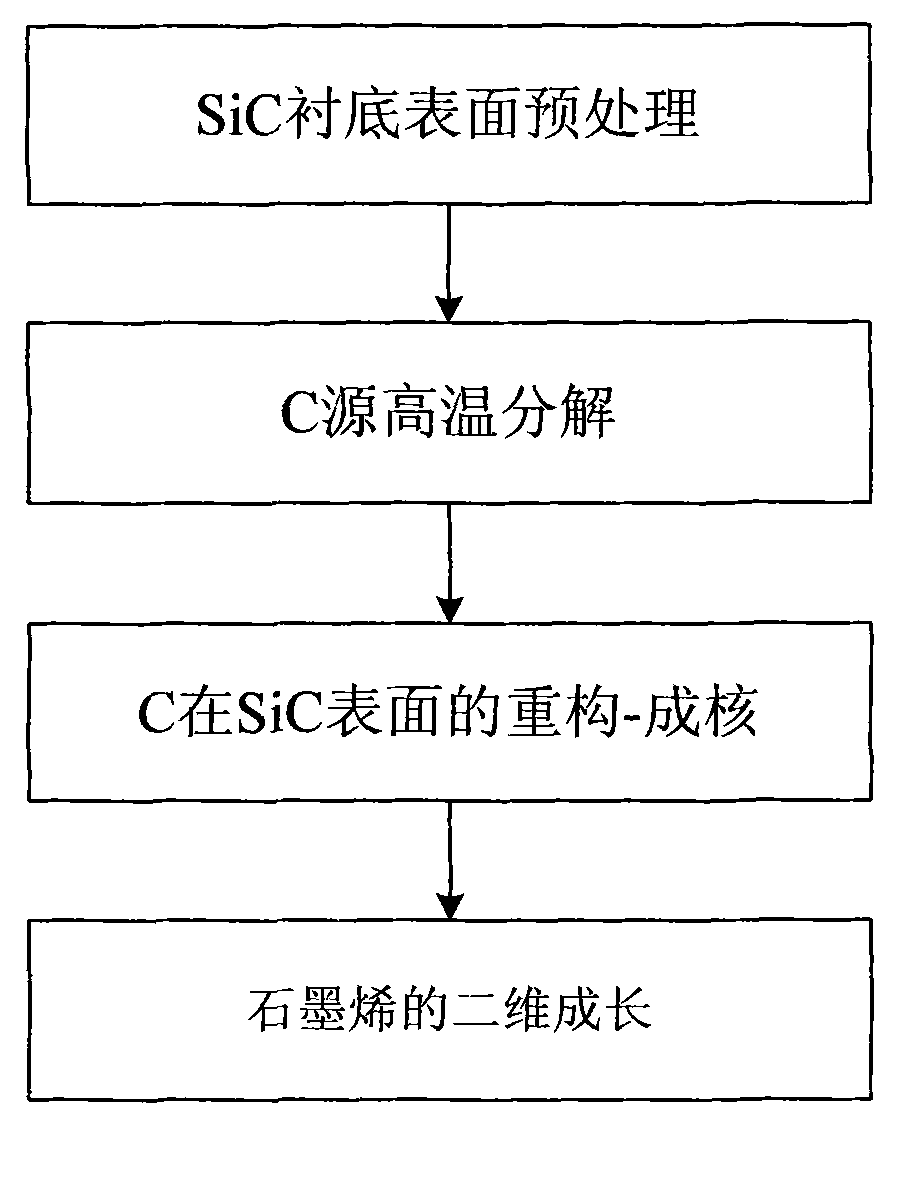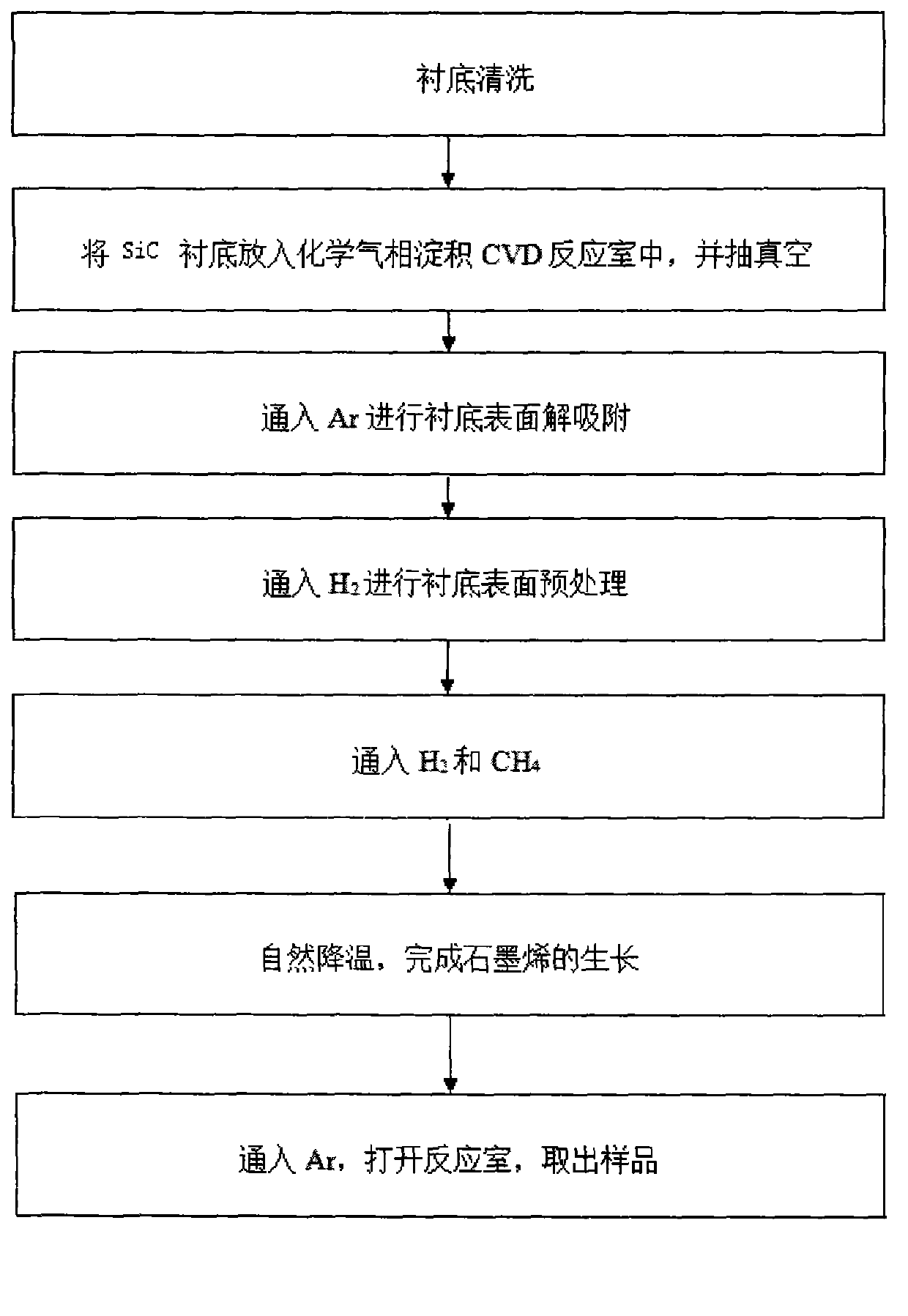SiC substrate-based graphene CVD (Chemical Vapor Deposition) direct epitaxial growth method and manufactured device
An epitaxial growth, graphene technology, applied in semiconductor/solid-state device manufacturing, electrical components, circuits, etc., can solve problems such as damage, affect the performance of graphene materials and devices, and cannot be directly applied, and achieve the effect of avoiding damage.
- Summary
- Abstract
- Description
- Claims
- Application Information
AI Technical Summary
Problems solved by technology
Method used
Image
Examples
Embodiment 1
[0020] Example 1 A graphene film is prepared on a silicon carbide substrate.
[0021] (1) Put the SiC substrate into acetone, ethanol and deionized water successively for cleaning, each time for 10 minutes, take out the substrate from the deionized water, and dry it with high-purity nitrogen (99.9999%).
[0022] (2) Put the SiC substrate into the chemical vapor deposition CVD reaction chamber, and draw a vacuum to 10 -5 Torr, to remove the residual gas in the reaction chamber;
[0023] (3) Pass high-purity Ar into the reaction chamber, keep the temperature at 150°C for 10 minutes, and then evacuate to 10 -5 Torr, discharge the adsorbed gas on the substrate surface.
[0024] (4) Introduce H into the reaction chamber 2 Perform substrate surface pretreatment, gas flow rate 1sccm, reaction chamber vacuum 0.1Torr, substrate temperature 1000°C, processing time 1min;
[0025] (5) Pass H into the reaction chamber 2 and CH 4 , keep H 2 and CH 4 The flow ratio is 10:1, H 2 Flow...
Embodiment 2
[0028] Example 2 A graphene film is prepared on a silicon carbide substrate.
[0029] (1) Put the SiC substrate into acetone, ethanol and deionized water successively for 8 minutes each time, take out the substrate from the deionized water, and dry it with high-purity nitrogen (99.9999%).
[0030] (2) Put the SiC substrate into the chemical vapor deposition CVD reaction chamber, and draw a vacuum to 10 -6 Torr, to remove the residual gas in the reaction chamber;
[0031] (3) Pass high-purity Ar into the reaction chamber, keep the temperature at 250°C for 30 minutes, and then evacuate to 10 -6 Torr, discharge the adsorbed gas on the substrate surface.
[0032] (4) Introduce H into the reaction chamber 2 Perform substrate surface pretreatment, gas flow rate 20sccm, reaction chamber vacuum degree 1Torr, substrate temperature 1100°C, processing time 10min;
[0033] (5) Pass H into the reaction chamber 2 and CH 4 , keep H 2 and CH 4 The flow ratio is 2:1, H 2 Flow 200sccm,...
Embodiment 3
[0036] Example 3 A graphene film is prepared on a silicon carbide substrate.
[0037] (1) Put the SiC substrate into acetone, ethanol and deionized water successively for cleaning, each time for 5 minutes, take out the substrate from the deionized water, and dry it with high-purity nitrogen (99.9999%).
[0038] (2) Put the SiC substrate into the chemical vapor deposition CVD reaction chamber, and draw a vacuum to 10 -6 Torr, to remove the residual gas in the reaction chamber;
[0039] (3) Pass high-purity Ar into the reaction chamber, keep the temperature at 100°C for 20 minutes, and then evacuate to 10 -6 Torr, discharge the adsorbed gas on the substrate surface.
[0040] (4) Introduce H into the reaction chamber 2 Perform substrate surface pretreatment, gas flow rate 10sccm, reaction chamber vacuum 0.5Torr, substrate temperature 1200°C, processing time 50min;
[0041] (5) Pass H into the reaction chamber 2 and CH 4 , keep H 2 and CH 4 The flow ratio is 5:1, H 2 Flow...
PUM
 Login to View More
Login to View More Abstract
Description
Claims
Application Information
 Login to View More
Login to View More - R&D
- Intellectual Property
- Life Sciences
- Materials
- Tech Scout
- Unparalleled Data Quality
- Higher Quality Content
- 60% Fewer Hallucinations
Browse by: Latest US Patents, China's latest patents, Technical Efficacy Thesaurus, Application Domain, Technology Topic, Popular Technical Reports.
© 2025 PatSnap. All rights reserved.Legal|Privacy policy|Modern Slavery Act Transparency Statement|Sitemap|About US| Contact US: help@patsnap.com


